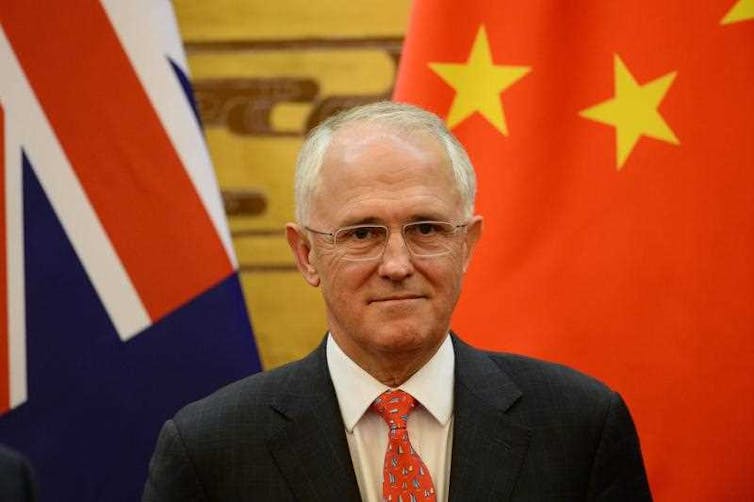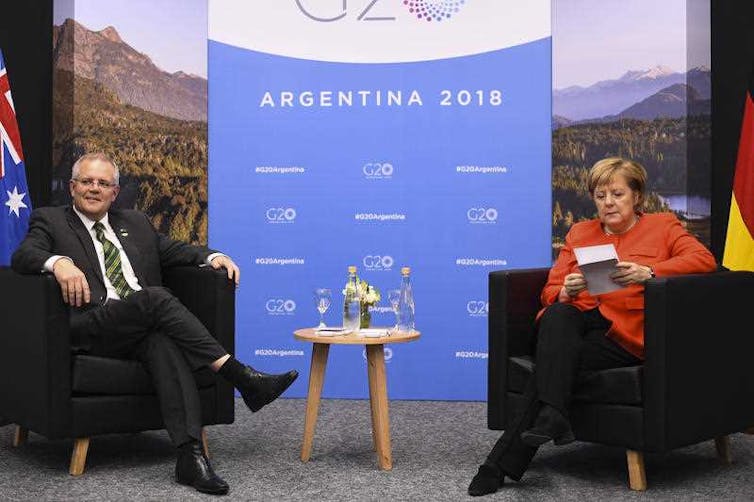Australia should brace for a volatile year in foreign policy in 2019
- Written by Susan Harris Rimmer, Australian Research Council Future Fellow, Griffith Law School, Griffith University
By the end of 2019 we should be able to assess how Australia is travelling with the grand plan laid out in the 2017 Foreign Policy White Paper. In this, an election year, I examine the status of our most important international relationships.
My verdict: decidedly shaky.
A difficult 2018
Even before the August leadership spill, 2018 was a difficult year for Australia’s foreign policy.
New prime minister Scott Morrison visited Jakarta within days of his appointment, but did not attend the Pacific Island Forum on Nauru. He also cancelled long-planned visits to Malaysia and Vietnam. He then jeopardised the Indonesian relationship with a rushed announcement about moving Australia’s embassy in Israel to Jerusalem.
Australia was increasingly criticised in various multilateral fora for its detention practices on Nauru and Manus Island, as well as its climate policies and defence of the coal industry. Morrison then had a shaky summit season.
Read more: With Bishop gone, Morrison and Payne face significant challenges on foreign policy
Relationship with China, Middle East
China put us in the “deep freeze” for most of the year, putting off visits between ministers, deferring a trip by the Department of Foreign Affairs and Trade secretary, and delaying a range of educational exchanges.
The Chinese embassy issued a safety warning to international students, a large market for international education. This was in response to then Prime Minister Malcolm Turnbull’s vow to crack down on foreign interference in Australian affairs, as well as our position on the South China Sea.
 Australia’s relationship with China has long been a crucial one, and was tested in 2018.
Parker Song/Pool/EPA/AAP
Australia’s relationship with China has long been a crucial one, and was tested in 2018.
Parker Song/Pool/EPA/AAP
In August, the federal government banned Chinese-owned tech giant Huawei from taking part in the roll-out of 5G mobile infrastructure over national security concerns.
This was the one relationship that may have benefited in the short term from the change in prime minister.
Despite these set-backs, the need to be principled and steady, and to build a long-term relationship with China, remains a challenge.
The year ended badly. With the West Jerusalem embassy announcement in December, Morrison proved a new diplomatic adage: that you can, in fact, please no one, all of the time.
Read more: Morrison's decision to recognise West Jerusalem the latest bad move in a mess of his own making
In the Pacific
Some issues are slow-burn. Most Australians still do not realise the deep implications for domestic policy raised by the Trans-Pacific Partnership deal that came into effect on December 30, 2018. These implications range from changes to labour market testing, intellectual property issues and the Investor-State Dispute Settlement (ISDS) provisions that allow private corporations to bypass national courts and seek compensation from extraterritorial tribunals if they believe a change in the law or policy has harmed their investments.
But one bright spot was the so-called Pacific pivot, which Morrison announced in November, and now has to be realised.
While the white paper laid out a stepping up in engagement, long overdue, with the Pacific, it was China’s increasing influence in the region that led to a sense of urgency and scale to the Pacific pivot announcement.
The announcement includes A$2 billion of new funding for infrastructure, a billion dollars to entice Australian businesses back into the region, adding five new diplomatic missions, enhancing labour mobility opportunities and creating an “office of the Pacific” with whole-of-government oversight. Australia, Japan, New Zealand and the US promised to connect electricity to 70% of PNG’s population by 2030.
These goals must be realised in a spirit of true partnership. Australian researcher Tess Newton Cain points out that Australia often misses the right tone of respect and partnership in its announcements to the region. And without climate leadership, will the Pacific trust us?
Leadership churn
No white paper can protect Australia from the damage to our international reputation over our constant turn-over of prime ministers. Based on current polls, another one is likely in May after a federal election.
The Lowy Institute’s Michael Fullilove says that worse than being a laughing stock, now Australia can be ignored while the region moves on.
The image of German Chancellor Angela Merkel barely concealing her boredom at meeting her fifth Australian leader in five years at the G20 Summit spoke volumes.
 German Chancellor Angela Merkel checks her notes as she meets Scott Morrison at the G20 summit in Buenos Aires, Argentina, in 2018.
Lukas Coch/AAP Image
German Chancellor Angela Merkel checks her notes as she meets Scott Morrison at the G20 summit in Buenos Aires, Argentina, in 2018.
Lukas Coch/AAP Image
Opposition leader Bill Shorten is not known for his foreign policy vision, but Penny Wong is a respected foreign policy thinker, and an interesting symbol for the region on diversity, multiculturalism and the rule of law.
Will she take the foreign minister role in cabinet if the ALP is elected, assuming she may have some choice? For Australia’s sake, she should; we desperate need steady interlocutors. Richard Marles is also a respected figure in the Pacific.
A Shorten government should also display bipartisanship and give Marise Payne and Julie Bishop roles as special envoys or ambassadors to shore up some degree of continuity. Former PMs Kevin Rudd, Julia Gillard and Malcolm Turnbull could all be given roles to play.
Big meetings ahead
Thailand will host ASEAN (Association of Southeast Asian Nations) and the East Asia Summit (EAS) in 2019. The 10-member association has been criticised for allowing Thailand’s military government to become chair.
APEC (Asia-Pacific Economic Cooperation) will be hosted by Chile in 2019, showing the reach of APEC across the Pacific. APEC was not able to produce a leaders’ declaration at the PNG summit and it was the scene of extraordinary tension this year. Chile will be hoping for a return to business as usual.
Japan will also host an early G20 Summit in Osaka in June, part of an enormous diplomatic year for them. In 2019, Japan is hosting the Rugby World Cup and preparing for the Tokyo Olympics in 2020. Then in April, Emperor Akihito, will abdicate, making way for his successor Crown Prince Naruhito.
Threats on horizon
The Council for Foreign Relations, an independent US think-tank, nominated its highest risks for 2019, which I have modified for Australia:
A highly disruptive cyber-attack on critical infrastructure and networks
Renewed tensions on the Korean peninsula following a collapse of denuclearisation negotiations
Armed conflict between Iran and the US or one of its allies
Armed conflict over disputed maritime areas in the South China Sea between China and one or more Southeast Asian countries (Brunei, Malaysia, Philippines, Taiwan, and Vietnam)
A mass casualty terrorist attack by either foreign or home-grown terrorist(s)
Continued violent re-imposition of government control in Syria
Deepening economic crisis and political instability in Venezuela leading to violent civil unrest and more refugees leaving
Worsening of the humanitarian crisis in Yemen, exacerbated by ongoing foreign intervention in the civil war
Increased violence and instability in Afghanistan resulting from the Taliban insurgency and potential government collapse.
International elections
The Indian general election is expected in April or May 2019, a test for Prime Minister Narendra Modi.
Other major elections in 2019 are due in Afghanistan, Canada, South Africa, Indonesia, Thailand and The Philippines.
Key partnerships
Alas, the UK remains focused on Brexit.
And all international diplomats are bracing themselves for the next phase of Trump’s foreign policy.
The US foreign policy think-tanks argue that with the Democrats in control of the House of Representatives, the Trump White House will be more active in foreign policy as it struggles to pursue a productive domestic agenda. This could lead Australia into some kind of rollercoaster if we are not willing to disengage from some US requests for our assistance.
In 2019, the US Ambassador to Australia will finally arrive after more than two years’ delay. Republican Washington lawyer Arthur Culvahouse might well spice things up during his posting.
He told the US senate that while China is Australia’s largest trading partner, Australia has also given China “a nation that’s already … aggressive” an “outsized” influence and opportunity to press its agenda.
Depending on the election outcomes, India is looking more like a natural ally for Australia, at least in the shared interest in strengthening ASEAN and the EAS process, and the early conclusion of the Regional Comprehensive Economic Partnership (RCEP) in which both countries are partners.
The way forward for Australia is clearer too, if the government adopts the approach laid out in Peter Varghese’s report An India Economic Strategy to 2035. The former diplomat and public servant envisages the goal by 2035 to be to:
… lift India into its top three export markets, to make it the third largest destination in Asia for Australian outward investment, and to bring it into the inner circle of Australia’s strategic partnerships and with people to people ties as close as any in Asia.
Strategy requires skill and leadership. We will need all three in 2019. We have a volatile year ahead.
Authors: Susan Harris Rimmer, Australian Research Council Future Fellow, Griffith Law School, Griffith University





